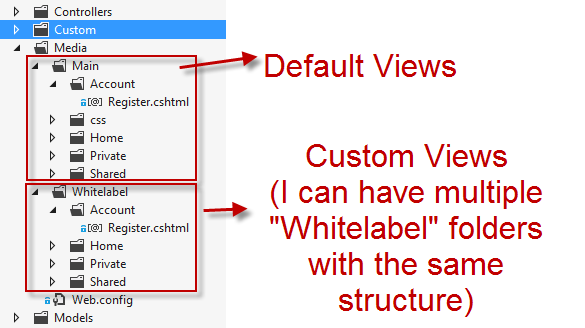So here is the situation, I need to build a personalization for the user where they can have different View files based on their user preference or alternatively they can pick their own View folder. To better explain the situation, look at the folder structure below
So basically, I don’t want it to be under “Views” folder anymore instead I want my views to be under “Media” folder and by default if the user hasn’t specified which “Views” folder that they want to select then it should use the default one which is “Main” folder
First of all, we need to create our own View Engine that inherits from “RazorViewEngine” and then we need to override the default “ViewLocation“, “PartialViewLocation” and “MasterLocation” with our own default location which is “Media”
Secondly, we need to override “CreateView” method and “CreatePartialView” method to replace the default view location with the one defined in database/user settings
*Note: in the code below “CacheManager.CurrentSite.FolderPath” is storing the “Views” folder that the user has selected in their profile. “UseCustomViewLocation” function is used in this case to not have the personalisation on any of the “Admin Area”
[code language=”csharp”]
using System;
using System.Collections.Generic;
using System.Linq;
using System.Web;
using System.Web.Mvc;
using System.IO;</code>
namespace WebUI.Custom.ViewEngine
{
public class WhitelabelViewEngine : RazorViewEngine
{
private const string WHITELABELVIEWFOLDER = "Whitelabel";
private const string MAINFOLDER = "Main";
private const string EXCLUDED_AREA = "admin";
public WhitelabelViewEngine()
{
base.ViewLocationFormats = new[] {
"~/Media/" + MAINFOLDER + "/{1}/{0}.cshtml",
"~/Media/" + MAINFOLDER + "/{1}/{0}.vbhtml",
"~/Media/" + MAINFOLDER + "/Shared/{0}.cshtml",
"~/Media/" + MAINFOLDER + "/Shared/{0}.vbhtml"
};
base.MasterLocationFormats = new[] {
"~/Media/" + MAINFOLDER + "/{1}/{0}.cshtml",
"~/Media/" + MAINFOLDER + "/{1}/{0}.vbhtml",
"~/Media/" + MAINFOLDER + "/Shared/{0}.cshtml",
"~/Media/" + MAINFOLDER + "/Shared/{0}.vbhtml"
};
base.PartialViewLocationFormats = new[] {
"~/Media/" + MAINFOLDER + "/{1}/{0}.cshtml",
"~/Media/" + MAINFOLDER + "/{1}/{0}.vbhtml",
"~/Media/" + MAINFOLDER + "/Shared/{0}.cshtml",
"~/Media/" + MAINFOLDER + "/Shared/{0}.vbhtml"
};
}
protected override IView CreatePartialView(ControllerContext controllerContext, string partialPath)
{
IView partialView = base.CreatePartialView(controllerContext, partialPath);
if (UseCustomViewLocation(controllerContext))
{
partialView = base.CreatePartialView(controllerContext, partialPath.Replace(MAINFOLDER, CacheManager.CurrentSite.FolderPath));
if (!File.Exists(controllerContext.HttpContext.Server.MapPath(((RazorView)partialView).ViewPath)))
partialView = base.CreatePartialView(controllerContext, partialPath);
}
return partialView;
}
protected override IView CreateView(ControllerContext controllerContext, string viewPath, string masterPath)
{
IView pageView = base.CreateView(controllerContext, viewPath, masterPath);
if (UseCustomViewLocation(controllerContext))
{
pageView = base.CreateView(controllerContext, viewPath.Replace(MAINFOLDER, CacheManager.CurrentSite.FolderPath),
masterPath.Replace(MAINFOLDER, CacheManager.CurrentSite.FolderPath));
if (!File.Exists(controllerContext.HttpContext.Server.MapPath(((RazorView)pageView).ViewPath)))
pageView = base.CreateView(controllerContext, viewPath, masterPath);
}
return pageView;
}
///
/// to check whether in the custom area or not
///
//////
private bool UseCustomViewLocation(ControllerContext controllerContext)
{
bool useCustomViewLocation = false;
if (controllerContext.RouteData.DataTokens["area"] == null || (controllerContext.RouteData.DataTokens["area"] != null && controllerContext.RouteData.DataTokens["area"] != EXCLUDED_AREA))
{
useCustomViewLocation = true;
}
return useCustomViewLocation;
}
}
}
[/code]
Lastly, We also need to register our custom view engine in Global.asax
[code language=”csharp”]
public class MvcApplication : System.Web.HttpApplication
{
protected void Application_Start()
{
WebApiConfig.Register(GlobalConfiguration.Configuration);
FilterConfig.RegisterGlobalFilters(GlobalFilters.Filters);
RouteConfig.RegisterRoutes(RouteTable.Routes);
BundleConfig.RegisterBundles(BundleTable.Bundles);
BootStrapper.Setup();
/*Register Whitelabel View Engine logic*/
ViewEngines.Engines.Clear();
ViewEngines.Engines.Add(new WhitelabelViewEngine());
}
}
[/code]

